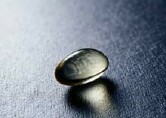No age- or sex-related variation in fractional disappearance rates, α-tocopherol absorbed
MONDAY, March 23, 2015 (HealthDay News) — Plasma α-tocopherol disappearance rates depend on lipid concentrations, not on age or sex, according to a study published online March 4 in the American Journal of Clinical Nutrition.
Maret G. Traber, Ph.D., from Oregon State University in Corvallis, and colleagues examined α-tocopherol’s bioavailability from food using collard greens grown in deuterated water as a source of deuterium-labeled (²H) α-tocopherol. Younger (mean age, 32 years; 12 women and nine men) and older (mean age, 67 years; eight women and 12 men) adults consumed a test breakfast that included 120 g ²H collard greens. Liquid chromatography-mass spectrometry was used to measure plasma unlabeled α-tocopherol and ²H-α-tocopherol from fasting blood samples and postprandial samples.
The researchers observed no variation between age groups or sexes in terms of times of maximum plasma ²H-α-tocopherol concentrations, fractional disappearance rates, half-lives, and the minimum estimated ²H-α-tocopherol absorbed. Compared with younger adults, older adults had higher concentrations of unlabeled α-tocopherol concentrations, and these correlated with serum lipids. ²H-α-tocopherol half-lives were associated with lipids.
“These data suggest that plasma α-tocopherol concentrations are more dependent on mechanisms that control circulating lipids rather than those related to its absorption and initial incorporation into plasma,” the authors write.
Hermes Arzneimittel GmbH donated the supplements used in this study; Eisai Food and Chemical Company provided the α-tocotrienol used for mass spectrometry.
Copyright © 2015 HealthDay. All rights reserved.








